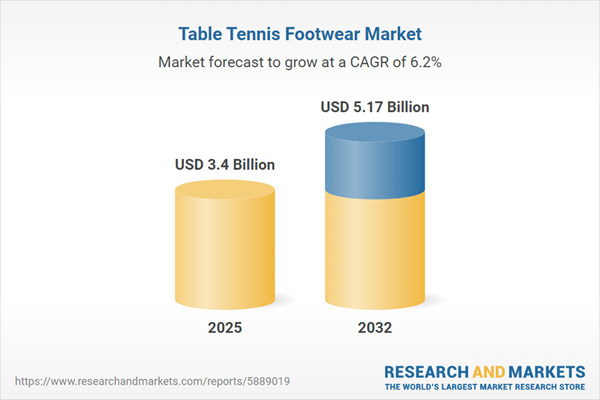Speak directly to the analyst to clarify any post sales queries you may have.
The table tennis footwear market is undergoing dynamic evolution as global brands navigate shifts in material innovation, consumer behavior, and supply chain realignment. Senior decision-makers face pressing choices to align business strategies with changing standards and competitive pressures, shaping their organizations’ long-term resilience and growth.
Market Snapshot: Table Tennis Footwear Market Overview
The global table tennis footwear market is projected to expand from USD 3.20 billion in 2024 to USD 3.40 billion in 2025, with an anticipated rise to USD 5.17 billion by 2032. This trajectory reflects a strong 6.20% compound annual growth rate (CAGR), propelled by heightened participation among professional athletes, recreational enthusiasts, and newcomers. As demand intensifies, established and emerging brands have responded by pursuing product innovation, adopting new materials, and fostering R&D collaborations. These actions support agility, adapt organizations to emerging regulations, and enable more targeted responses to diverse performance expectations.
Scope & Segmentation of the Table Tennis Footwear Market
This report gives leadership teams the visibility needed to evaluate new opportunities and refine strategies for both procurement and expansion. The following segmentation outlines the main drivers influencing both immediate and long-term competitive positioning:
- Product Types: Technical footwear maximizes player agility and grip, serving performance-focused users, while comfort and versatility options expand the market to casual and entry-level participants.
- Material Types: Composite soles and modern rubber compounds improve stability and on-court performance. Durable synthetics increase lifespan, and progressive textiles offer breathability to support high-mobility activity.
- Age Groups: Diversified collections address needs across adults, youth, and children, ensuring product relevance throughout the player lifecycle and capturing growth within emerging demographics.
- Distribution Channels: Supplementing traditional retail, specialty outlets, online platforms, and direct-to-consumer models increase product availability in both mature and high-growth regions.
- Regional Focus: The Americas and Europe benefit from established institutional alliances; the Middle East and Africa center on operational adaptability and local compliance; Asia-Pacific leverages rapid manufacturing and broad distribution networks to drive momentum.
- Key Companies Tracked: Sector leaders such as ASICS, Li-Ning, Adidas, Mizuno, Yonex, Tamasu, Stiga Sports, Donic-Schildkröt, JOOLA Sport, and Nittaku advance through research investment and expanded organizational networks.
- Technology Adoption: Embracing recycled components, advanced outsole technologies, and integrated digital logistics helps streamline procurement and sales, enhancing monitoring and operational efficiency sector-wide.
This segmentation enables executive leaders to anticipate advances in smart materials, monitor consumer trends, and optimize sourcing strategies for the changing business landscape.
Key Takeaways: Strategic Insights for Senior Decision-Makers
- Prioritizing the integration of ergonomic features and technical performance into product development drives broader market traction and promotes lasting customer engagement.
- Strengthening omnichannel strategies—utilizing both digital platforms and physical outlets—extends brand reach and adapts to regional retail preferences.
- Commitment to transparent supply chains and responsible sourcing strengthens stakeholder relationships and supports compliance in interconnected global networks.
- Adjusting operational models to localize compliance and cultural alignment sustains competitiveness and protects regional market shares.
- Collaborative R&D and investment in automated manufacturing facilitate early adoption of new trends and expedite market responses.
Tariff Impact: Policy-Driven Supply Chain Adjustments
Recent tariff measures enacted in the United States have driven table tennis footwear companies to reassess and enhance supply chain resilience. Brands now increasingly relocate or diversify production into Southeast Asia and Latin America, addressing emerging currency risks and regulatory changes. By optimizing procurement and expanding logistics options, organizations sustain reliable product supply while reinforcing market responsiveness amid global trade uncertainty.
Methodology & Data Sources
Analytical findings in this report stem from direct engagements with senior business leaders, structured input from footwear designers and athletes, and verified industry data. This multipronged research approach produces actionable recommendations for B2B strategic planning in the table tennis footwear market.
Why This Report Matters
- Equips decision-makers with practical insights to inform investment and operational direction in table tennis footwear.
- Clarifies how changing consumer preferences and evolving regulations may alter market position and highlight key areas of risk mitigation.
- Enables the design of adaptive procurement and distribution strategies, supporting sustained competitive advantage in global and local markets.
Conclusion
This analysis supplies executive teams with the intelligence needed to navigate sector transformation, capture emerging opportunities, and advance organizational priorities for sustainable market presence in the global table tennis footwear sector.
Additional Product Information:
- Purchase of this report includes 1 year online access with quarterly updates.
- This report can be updated on request. Please contact our Customer Experience team using the Ask a Question widget on our website.
Table of Contents
3. Executive Summary
4. Market Overview
7. Cumulative Impact of Artificial Intelligence 2025
Companies Mentioned
The companies profiled in this Table Tennis Footwear market report include:- ASICS Corporation
- Li-Ning Company Limited
- Adidas AG
- Mizuno Corporation
- Yonex Co., Ltd.
- Tamasu Co., Ltd.
- Stiga Sports AB
- Donic-Schildkröt GmbH & Co. KG
- JOOLA Sport GmbH
- Nittaku Co., Ltd.
Table Information
| Report Attribute | Details |
|---|---|
| No. of Pages | 194 |
| Published | November 2025 |
| Forecast Period | 2025 - 2032 |
| Estimated Market Value ( USD | $ 3.4 Billion |
| Forecasted Market Value ( USD | $ 5.17 Billion |
| Compound Annual Growth Rate | 6.2% |
| Regions Covered | Global |
| No. of Companies Mentioned | 11 |









